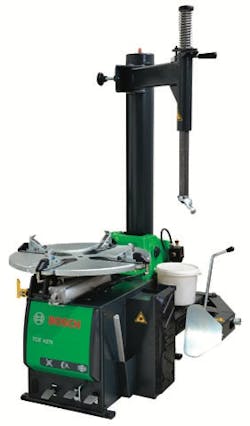Clad wheels require extreme care during mounting and balancing. Without it, a dealer will pay the ultimate price: replacing the wheel. Some dealers are acutely aware of the latest market trend affecting mounting and balancing. “We see a lot of them,” says Jim Ramsey, CEO and president of Lamb Ventures LP, which does business as Lamb’s Tire & Automotive. “It looks like a nice chrome wheel but it’s plastic. If you’re not careful, you’ll break it. There’s no repairing it; you have to get another wheel.”
For other dealers, clad wheels are not an issue, at least not yet. “To date I’ve not seen many of those kinds of wheels,” says Terry John, owner of Mid-Atlantic Tire LLC, which does business as Mid-Atlantic Tire Pros. His store recently received Five-Star dealer status from the Tire Pros organization and has provided service to nearly 50,000 customers. The five-bay store is in rural Easton, Md.
“Our percentage of higher-end vehicles with aluminum alloy wheels is much smaller than Annapolis or Washington, D.C.,” John says. “We do a lot of trucks and family vehicles, and they historically do not have wheels that are easily damaged.”
But the mix of wheels coming to John’s shop will surely shift to more cladded chrome wheels, according to equipment manufacturers.
“There is a significant trend toward these wheels,” says Greg Meyer, product manager, wheel balancers for Hunter Engineering Co. “The plastic cladding on these wheels gives a very smooth and expensive appearance without the cost of highly polished chrome wheels.” Meyer says clad wheels have proven popular with customers.
Plastic clad wheels are a recent phenomenon dealers are struggling with, according to Scott Farr, wheel service and equipment business development manager for Bosch Automotive Service Solutions LLC. “Clad wheel proliferation is pretty extreme right now. There’s not a day goes by in a shop in North America where they’re not confronted by some type of cladding.”
A clad wheel is an alloy wheel with a delicate chrome-painted plastic cover bonded to the face of the wheel. For car manufacturers, clad wheels are more cost-effective than traditional chrome wheels. “Alloy wheels are cast for fit and style. Many OEs have multiple brands, such as Dodge/Chrysler or Chevrolet/Buick, that utilize the same base casting but with different fascia,” says Farr. “With casting it is less expensive to make changes to style and appearance.”
However, clad wheels can be far from cost-effective for shops that service them. “The plastic cladding is delicate and can be easily damaged,” says Meyer. The clad wheel covers cannot be removed, repaired or replaced. If they are damaged during balancing or mounting, the wheel must be replaced at the dealer’s expense.
Don’t touch the plastic
Clad wheels affect both the balancing and mounting processes. For example, pressure cups and cones cannot be used to balance a clad wheel. Meyer explains: “On the balancer, it is common to use a cup with a rubber protective ring to contact the face of a steel or alloy wheel. With clad wheels, the pressure from a cup can crack the plastic cladding. For these wheels it is recommended to use a flange plate. A flange plate has pins that only contact the wheel in the lug holes where the lug nuts would contact the wheel, avoiding damage.”
Traditional cones can also cause damage to this cladding when they drop far enough into the bore of the wheel to contact the plastic cladding, according to Meyer. “Hunter recommends our BullsEye collets to avoid this. They can only drop half as far into the wheel bore and therefore don’t contact the plastic cladding.
“In addition, the cladding on the exterior surface of the wheel also prevents clip weights from being used on this outer surface. These wheels must use tape weights on the outer plane (inside the wheel) to avoid damaging the cladding.
“When mounting tires, the same care must be taken to not contact the plastic with a flange plate or center bore clamping, but we must also be sure to not damage the plastic on the outer diameter of the wheel as well.”
Along with being prone to damage, clad wheels are difficult to balance, according to Farr. “Clad wheels have a plastic cover fused to a base casting in varying methods. One method is through the center bore with tabs. These tabs can interfere with balance accuracy.”
Break the back bead first
Tire changing also carries special considerations, says Pete Liebetreu, senior product manager at Hunter. For example, when bead breaking with a side shovel changer, it is important to be careful or the cladding face can crack when placed against the back pad.
“It is best to break the back bead first so that the tire can help to keep the wheel off the back pad. Then care must be used not to damage the clad face of the wheel with the shovel.”
Liebetreu notes that some cladding extends and covers the center hole. Flange plates must be used to service these types of wheels safely when clamping clad wheels with center clamp style tire changers.
“All tire changer types, except automatic models like Revolution, require extreme care when using a mount head or bead lever on the clad surface,” he says. “Again, the plastic cladding can be damaged by the lever or scratched by the head.
“Many mount heads on low-end tire changers are not sufficiently wide to accommodate the extra flange thickness that a clad wheel demands. This needs to be monitored as well,” says Liebetreu.
Rethink accessories
Accessories are the key to avoiding damage to clad wheels. “Flange plates are the most significant accessory in combating damage to these wheels,” says Meyer. “They contact the wheel in the same location as the wheel lugs thereby avoiding damage. Our collets also play an important role in avoiding damage to these wheels. Traditional cones can protrude far enough into the bore of the wheel and contact this plastic cladding.
“Hunter’s collets are split tapered, which means they are tapered in opposite directions from the center of the collet. This means that the collet can only penetrate half as far into the bore of the wheel and therefore avoids contact with the plastic cladding,” says Meyer.
Bosch offers a variety of balancing accessories, such as pin plates, to assist with balancing accuracy, according to Farr. “We also advocate external clamping of wheels when servicing on rim-clamp style changers. Our ErgoControl bead breaker provides pinpoint control while unseating beads in close proximity to vulnerable clad fascia.”
Take time with the wheel
John uses Hunter equipment in his Tire Pros shop. “Our tire machines have kind of ‘space age’ plastic heads on them that we use when working on fancier rims, and we have had no incidents of scuffing or scratching with the heads.”
But equipment and accessories go just so far. The time technicians take to do the rims is where shops differentiate themselves, according to John.
“I think that’s the secret in anything with the installation. You’ve got to take time with the wheels on some of these luxury vehicles. We do that here. The philosophy of Tire Pros is to make sure that we have processes in place where we are looking out for the customer,” says John.
Ramsey, who also uses Hunter tire equipment in his stores, agrees time and care are essential to servicing clad wheels. A technician has to be “very, very careful” not to hit the cladding when breaking the bead. After the bead is broken, the tech has to be very careful with the bar that takes the tire off the wheel.
“It’s just a matter of taking your time and being careful. There’s not a whole lot of training you can do for that.” ■
About the Author

Ann Neal
Ann Neal is a former senior editor at Modern Tire Dealer.
